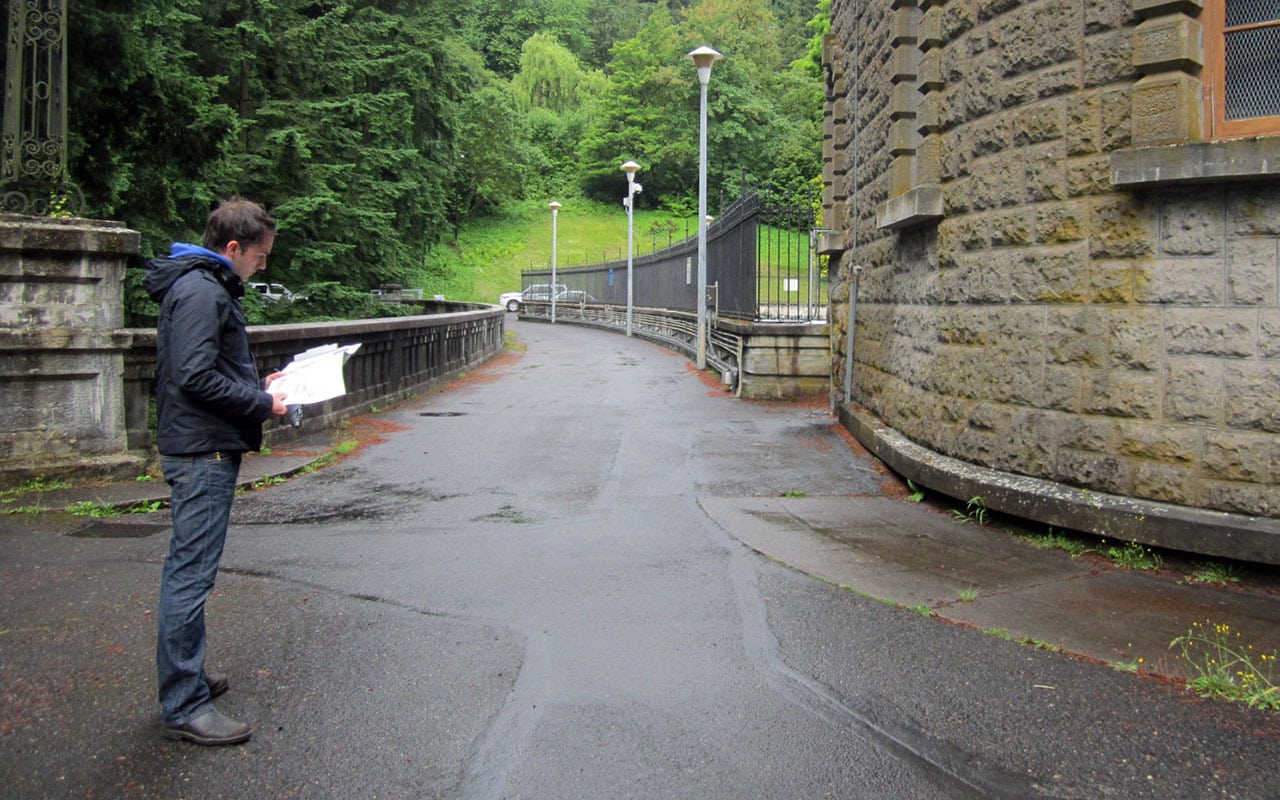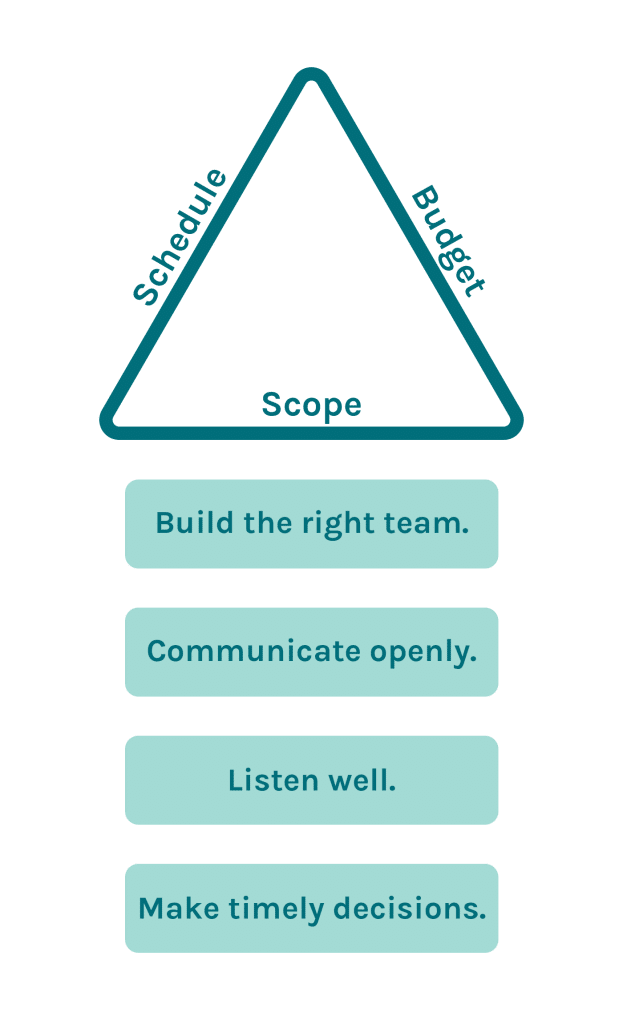
Four Things About Project Management They Don’t Teach You in School
In school, we learn about the Project Management Triangle, which states a project manager is responsible for three crucial project-delivery components: maintaining the scope, keeping the schedule, and delivering the project within the negotiated budget. I have found these responsibilities unachievable—or at least unnecessarily challenging—without these four other highly important elements in place: building the right team, communicating openly and honestly with client partners, listening well, and knowing when to make timely decisions.
Project management is a tricky undertaking. Successful project managers know enough about the technical aspects to answer difficult questions, but they also recognize and are honest about what they do not know. They build a strong team with diverse talents and subject matter experts to fill those gaps. They know how to be a good listener and when to act and make timely decisions.
Combined, project management is a complicated balancing act that may not appeal to everyone as a career. When it works, however, it is a highly rewarding experience. That’s why I’m sharing my approach for successful project delivery, which relies on the following off-the-books skills and, coincidentally, makes a challenging job enjoyable.
1. Build the right team.

Right out of the gate, I suggest you build a team tailored to your project’s individual needs. It seems elementary, but what does it really mean? And how does somebody do that?
Identify project needs.
Let me start by breaking down how I built a team of more than 35 for a recent Tualatin Valley Water District project. The Taylors Ferry Reservoir Replacements and Pump Station project involves sequenced demolition and removal of two reservoirs and construction of their replacements, a new pump station, and an operations equipment storage building. Internally, we needed a team experienced in restrictive site layout, complex site piping design with various operational modes, and land use and jurisdictional agency compliance. We also needed a structural engineer, a geotechnical engineer, surveyors, permitting specialists, and an electrical and instrumentation and controls designer.
I called my longtime structural engineering partner, Peterson Structural Engineers, the regional specialist in prestressed concrete reservoir design. I asked my colleagues to help find a trusted specialist for site investigations to handle the defunct office building and old fuel storage tanks on site that may or may not have materials classified as hazardous associated with their construction. After bringing in the other specialists, I assembled what I like to think of as the A-Team.
Connect on a personal level.
I am fortunate every time I work with these people. I do not lose their business cards and do take them out to coffee or happy hour. I make it a point to let them know how much we appreciate their work. For any sought-after teaming partners I have not met, I pick up the phone and call them. They like interesting work, too, and it may be the best way to strike gold and start a beautiful working relationship. My best tip for building any project team: ask potential clients who they like working with. It is an easy, surefire way to let them know you care and listen well!
Like the external partners on my project teams, I fill my internal teams with people who have helped me deliver other similar projects. And I let them know how much I value their expertise, work ethic, and execution. Just because I see them every day in my office does not mean I should take them for granted. I work hard to find new and meaningful ways to let them know they are talented, valuable, and key to the success of our shared projects. I have learned if I do that, these talented people will be excited to work on future projects with me.
Listen, we must admit as we develop as project managers, we cannot do the day-to-day, down-and-dirty design work while handling client expectations and maintaining the project’s scope, schedule, and budget. Learning this sooner rather than later saves many long nights doing work better done by other highly capable team members looking for opportunities to grow their skills.
Do not forget that clients are like other members of your teams in many ways. While clients ask questions and get to know me and my team’s capabilities, I put myself in the mindset that I am interviewing them, too. It is important to know what their capabilities and strengths are. Things are much easier when I work for people I share interests and temperaments with, and it is a nice coincidence when they also have cool projects I want to work on. Sometimes we must take projects as they come along, but other times we should be selective in the work we choose to do. Delivering quality project management for our clients is a talent, and we need to recognize our time is valuable. We will always do our best work when working with people we like on projects we enjoy.
2. Communicate openly and honestly with your client partners.
Clients do not know everything about a project. That is why they hire consultants. They rely on us to get them through the unknowns and do the heavy lifting on all aspects of the project. But consultants do not know the answers to all project questions either, so it is important to be honest about these limitations.
A good relationship with any potential client should start before proposing on the project, and the sooner the better.
Lay a foundation of trust.
I have found trust does not readily come from a conversation sparked up over an RFP, but by being available to answer questions, act as a sounding board for ideas, offer constructive feedback, or help find funding for a project they could not otherwise afford. It takes effort and a genuine desire to help, but you should work to become their trusted advisor instead of their big-project delivery person.
I first met with Seattle Public Utilities in 2018 after they inquired about Consor’s experiences and knowledge as a leader in designing projects centered around new and retrofitted AWWA D110, Type I prestressed concrete reservoirs. I was genuinely excited to talk with SPU not about a particular project but about the unique benefits and characteristics of these tanks generally, as well as construction timelines, siting concerns, and standard industry costs. Through the next couple of years, we built a strong working relationship before we even worked on a project. I have now been formally collaborating with SPU on the Bitter Lake Reservoir Improvements project for nearly four years. Once we are through project designs, permitting, and construction, we will have worked together for another seven years—that is over 11 years on the same project!
Be genuine.
If I were in it more for the sale than the people and projects, I am certain these smart people would see right through that. They are not buying some disposal commodity; they are building critical infrastructure for the cities they live in and love. If they ask someone to be a part of that, it should be respected and honored.
Now for another dose of honesty: every project will have ups and downs. A good relationship will endure through it all. Sometimes, I have to communicate difficult news, like scope creep or unforeseeable permitting conditions, but honest and open communication, especially during challenging times, is essential to maintaining the built trust.
3. Listen well.
Our client’s problems are our problems. Whatever challenges they may face during a project, within reason, is on us to help them solve. And that requires accurately hearing the problem first.
Find ways to lighten their load.
If your client partners do not have internal staff to help them deliver the project, it’s your job to help make less work for them to internally deliver the project. If they are battling timelines and conflicting schedules, let’s pull open the schedule and see what needs to be adjusted. Maybe there is some thread to pull that is a solution to a host of issues they are dealing with—consultants have the experience to help them identify that. I take notes, listen closely, wait until they are done talking, ask questions, and maybe they don’t want any suggestions for assistance or action at that time, but if they do…
4. Know when and how to make timely decisions.
At this stage, we should be set. We have listened closely to our client’s needs and issues throughout the project. We have built a capable project team. We know we have a schedule to meet. But what happens when an unforeseen critical issue has surfaced?
While these situations are expected, it’s important to remember this has happened before on other projects, and the client is relying on the team to make a timely, and likely critical, decision.
I say to myself: We’ve got this.
Establish consensus.
I collaborate with my well-chosen teammates and client partners to build a consensus as directly and as quickly as possible. I do not make these decisions in a vacuum, regardless of how confident I may be in a proposed solution. I have found it is better to not be a hero in these situations. Let’s only say that I have learned my lessons, and I do not wish to repeatedly learn the same thing more than necessary.
Working with an entire team of trusted specialists allows us to efficiently and quickly create a unified idea built on common sense, practicality, and sound engineering judgment. So there is buy-in from the entire project team, it is not only helpful but strongly recommended to involve the client in this decision-making process as much as possible, too. It’s like my kids remind me when they make the play in basketball: when you are in the game, always be on your toes and always look to every teammate to help you out.
Do it all with confidence and joy.
The project management skills we learn in school only scratch the surface of what it takes to be successful and to find enjoyment in this role. I keep learning on the job, one project at a time, and have been fortunate to have the patience of my mentors alongside an ability to take direct feedback delivered by some great clients.
We should not think of ourselves as being on an island; we are surrounded by talented people who look out for us while we look out for them. A great project team is like any other great team—everyone brings their specific skills and personal strengths.
A project manager’s skill set is based on smoothly moving from one project decision and major deliverable to the next, making sure this is done with enough enjoyment for everyone and taking many burdens from the client. Like all hard work, providing great project management is its own reward. I say that finding ways to enjoy my work and the people I work with is a must because I am not only thinking about today but the future.
